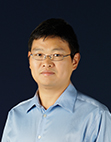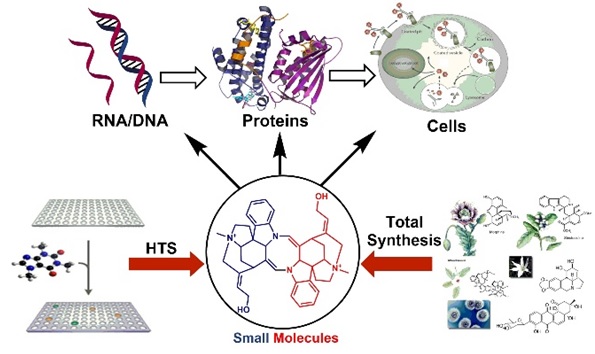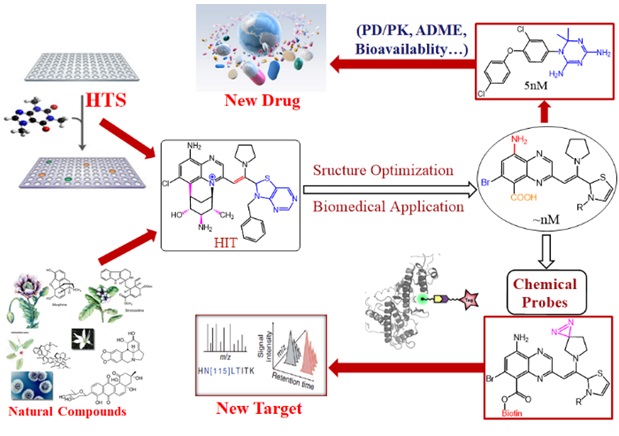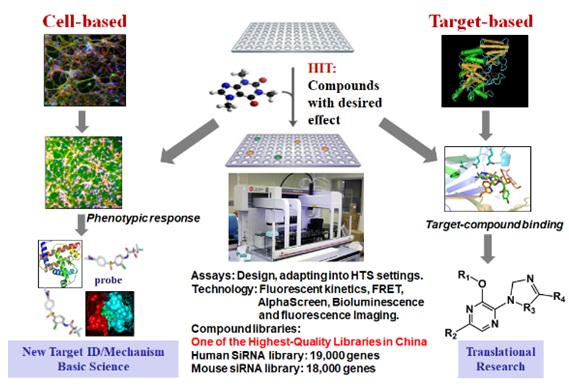Postgraduate
Xiangbing Qi, Ph.D.
- Information
- Education
- Experience
- Research
- Publication

Xiangbing Qi, Ph.D.
Director of Chemistry Center
National Institute of Biological Science, Beijing
Tel: 010--80726688轉(zhuǎn)8655Fax: 010-8070-8048E-mail:qixiangbing@nibs.ac.cn
Homepage:http://qigroup.nibs.ac.cn/
Education
2005-2009年 美國德州大學(xué)西南醫(yī)學(xué)中心生物化學(xué)系,有機(jī)化學(xué)博士學(xué)位
Ph.D. Organic Chemistry,Department of Biochemistry,University of Texas Southwestern Medical Center at Dallas
2001-2004年 同濟(jì)大學(xué)化學(xué)系,有機(jī)化學(xué)碩士學(xué)位
M.S. Organic Chemistry, Department of Chemistry, Tongji University
1997-2001年 濟(jì)南大學(xué)化學(xué)化工學(xué)院,應(yīng)用化學(xué)學(xué)士學(xué)位
B.S. Applied Chemistry, School of Chemistry and Chemical Engineering, University of Jinan
Professional Experience
2013-
Director of Chemistry Center, National Institute of Biological Sciences, Beijing, China
2010-2013
Postdoctoral Fellow, Organic Chemistry and Medicinal Chemistry, Department of Biochemistry,University of Texas Southwestern Medical Center at Dallas.
2009-2010
Postdoctoral Fellow, Organic Chemistry,Department of Chemistry,University of Illinois at Urbana-Champaign.
2004-2005
Research Assistant, Organic synthesis/Medicinal chemistry,Shanghai Institute of Organic Chemistry, Chinese Academy of Science.
化學(xué)中心/齊湘兵實(shí)驗(yàn)室:Qi Group@NIBS
北京生命科學(xué)研究所化學(xué)中心齊湘兵實(shí)驗(yàn)室主要研究方向?yàn)榫哂猩锘钚缘挠袡C(jī)小分子合成與藥物開發(fā), 天然藥物分離純化與結(jié)構(gòu)分析鑒定,化學(xué)小分子庫的構(gòu)建和高通量篩選,天然小分子全合成和生物仿生合成,同時(shí)開發(fā)新型化學(xué)小分子探針用于鑒定藥物新靶點(diǎn)并通過探索化學(xué)生物學(xué)新策略研究小分子與靶點(diǎn)的相互作用關(guān)系調(diào)控重要的生物學(xué)機(jī)理。我們實(shí)驗(yàn)室還為研究所的各實(shí)驗(yàn)室創(chuàng)建高質(zhì)量的輔助平臺(tái),提供專業(yè)的化學(xué)服務(wù)并與生物實(shí)驗(yàn)室緊密合作開展前沿交叉課題,基于生物基礎(chǔ)研究進(jìn)展,結(jié)合現(xiàn)代藥物研發(fā)的最新技術(shù)手段包括計(jì)算機(jī)輔助設(shè)計(jì)以及高通量篩選等,配以先進(jìn)的儀器裝備(NMR,LCMS,HPLC,GC/MS)協(xié)助各實(shí)驗(yàn)室開發(fā)全新的生物醫(yī)藥靶點(diǎn)并通過化學(xué)小分子探究與調(diào)控重要的生物學(xué)途徑。我們課題組核心部分主要包括:化學(xué)合成實(shí)驗(yàn)室,分析檢測實(shí)驗(yàn)室和高通量篩選實(shí)驗(yàn)室。我們將緊密地把有機(jī)合成,藥物化學(xué),化學(xué)生物學(xué)與生命科學(xué)相結(jié)合,從而為北京生命科學(xué)研究所建立起一套完善的化學(xué)服務(wù)與創(chuàng)新型藥物研發(fā)平臺(tái)和團(tuán)隊(duì)。
Research Interest: Reseach@Qi Group

Our lab is focused on the interface of biocatalysis, natural product biomimetic synthesis and biologically valuable molecule discovery. We are encouraged by the rapid and efficient construction of molecular complexity from simple precursors in living organisms by enzymatic pathway. On the microcosmic molecular level, enzyme catalyzed organic bond formation provided fundamental details of the molecular activation between catalyst and substrates through either non-bonded or covalent-bonded interactions. Inspired by the three-dimensional structure of the active binding residues of the enzyme pocket, we are interested in developing organic small molecule catalyst for stereoselective construction of chemical bonds that otherwise tough to access. Privileged coordination of transition structure geometries and molecular recognition that control selectivity will be explored in details by computational calculation and chemical kinetics. The utility of these small molecule catalysts will be demonstrated by the synthesis of a variety of important biologically interesting compounds through environmentally friendly organocascade process that involve the formation of several chemical bonds and stereogenic centers simultaneously with excellent stereoselectivity. Structurally complex natural products are naturally produced in microorganisms through a series of elaborate biological pathways, so its biomimetic synthesis will be incorporated with organocascade catalysis in the lab. Besides discovery of small molecule catalysis and natural product biomimetic synthesis, we are also interested in developing novel reagents for practical transformations to rapidly assemble unnatural complex molecules. The combination of chemical synthesis and biosynthesis of biologically valuable molecules is an important part of our pursuits for exciting discoveries of biomaterials, chemical biology as well as pharmaceutical agents to solve serious health problem in living system.
Overall, the inspiration from natural living system to develop small molecule catalyst, organocascade assembling of complex molecule will eventually result in discovery of novel bio-valuable molecules, which in turn serve as significant regulatory tools for a variety of biological pathways in living system. During this conceivably “functional cycle”, small molecule and living organism can be thought of as complementary forces that interact to form a dynamic system in which each could promote mutually by the other. We presumptively demonstrate this as “Functional Reincarnation of Organic Molecule”, thereupon we bear persistent enthusiasm for the pursuit of ideal discovery of novel molecules and interpretation their bioactive mechanism of act.
Total Synthesis of Natural product:

Inspired by the rapid and efficient construction of molecular complexity from simple precursors in natural living system by enzymatic pathway, our lab is mainly focused on the biocatalysis development and the utilization of biomimetic synthesis of natural products and biologically valuable small molecules. The utility of biomass-derived building blocks will be demonstrated by the synthesis of a variety of natural products through environmentally friendly organocascade process that involve the formation of several chemical bonds and stereogenic centers simultaneously with excellent stereoselectivity. Structurally complex natural products are naturally produced in microorganisms through a series of elaborate biological pathways, so its biomimetic synthesis will be incorporated with organocascade transformations in the lab. Furthermore, the mode of action studies are highly investigated in the lab to reveal the role that natural products have and will continue to play in mapping important biochemical networks and identification of novel therapeutic targets.
Medicinal Chemistry:

The use of small molecules to probe systematic and disease-associated biological phenomena is an important aspect of our research. Motivated by the urgent and valuable applications of small molecules in therapeutics and biomedical research, we are devoted to synthesizing new organic, inorganic, and organometallic molecules that applicable to a wide variety of biological areas conducted at NIBS. We are working on the molecule discovery and collection through synthetic method development with the aim of expanding chemical diversity in novel ways. Molecules synthesized in the our lab are inherently integrated for the purpose of examining their biological properties. The outcomes of this biological evaluation and the performance in biological screening are the main guidance for further synthesis design. After a range of chemicals is screened against a particular drug target or disease model, and the qualified “hits” chemicals are concentrated and analyzed. Commonalities among the different chemical groups are studied as they are often reflective of a particular chemical subunit. Additional chemical synthesis will be enforced to extend out the chemical library through “activity-oriented synthesis” in that particular subspace by generating more compounds with subtle and profound modifications. This new selection of compounds within this narrow range are further investigated and then taken on to more sophisticated models for further validation. Chemical compounds need to satisfy a variety of constraints before they become pharmaceutical candidate, including solubility, oral bioavailability, cell membrane permeability, liver enzyme activity, plasma protein binding, penetration of the blood-brain barrier, toxicity, and many others. We are focusing on the structure design to improve molecular properties that are not limited to known druggability rules.
High-Throughput Screening:

HTS is a drug-discovery process widely used in the pharmaceutical companies and biomedical research institutes. Using robotics, data processing and control software, liquid handling devices and sensitive detectors, HTS conduct extremely scalable assay to test the biological or biochemical activity of a large number of small molecules for discovering active agents for receptors, enzymes, ion-channels or other pharmacological targets in the molecular and cellular level of biomolecular pathway. Typically, HTS assays are performed in microtiter plates with a 96 or 384 well format. HTS is one of main facilities in our lab to provide comprehensive services including the use of HTS technology, compounds in various libraries, a database of results from screens and lead optimization. On a collaborative basis, HTS has the capability to support cellular and biochemical assays using absorbance, fluorescent kinetics, fluorescence resonance energy transfer, AlphaScreen, bioluminescence and cellular fluorescence imaging. In addition, HTS has expertise in adapting those biological and biochemical bench-top assays into high-throughput screening settings.HTS librariesare designed for diversity that not only limited to specific pharmacophore, bioactivities or specific focused collections. Biomedical and clinical property profiles will be highly considered for the library design and construction process.
1. Lei Zhang, Ye Zhang, Wenting Li, Xiangbing Qi, “Total Synthesis of (-)-Alstofolinine A through a Furan Oxidation/Rearrangement and Indole Nucleophilic Cyclization Cascade” Angew. Chem. Int. Ed. 2019, https://doi.org/10.1002/anie.201900156.
2. Yu Zhou, Yuanxun Wang, Pengfei Li, Xi-Ping Huang, Xiangbing Qi, Yunfei Du, and Niu Huang. “Exploring Halogen Bonds in 5-Hydroxytryptamine 2B Receptor–Ligand Interactions” ACS Med. Chem. Lett., 2018, 9 (10), pp 1019–1024.
3. Chao Wei, Xiao Han, Danwei Weng, Qiru Feng, Xiangbing Qi, Jin Li & Minmin Luo. “Response dynamics of midbrain dopamine neurons and serotonin Interactions neurons to heroin, nicotine, cocaine, and MDMA” Cell Discovery, 4 : 60 (2018) 1019–1024.
4. Aaron Nash, Xiangbing Qi, Pradip Maity, Kyle Owens, and Uttam K. Tambar*. “Development of the Vinylogous Pictet-Spengler Cyclization and Total Synthesis of (±)‐Lundurine?A” Angew. Chem. Int. Ed., 2018, 57, 6888-6891.
5. Rui Lin, Qiru Feng, Peng Li, Ping Zhou, Ruiyu Wang, Zhe Liu, Zhiqiang Wang, Xiangbing Qi, Nan Tang, Feng Shao, Minmin Luo, “A hybridization-chain-reaction-based method for amplifying immunosignals” Nature Methods, 2018 (4), 275
6. Xuekai Zhang, Gang Lu, Meng Sun, Madhu Mahankali, Yanfei Ma, Mingming Zhang, Wangde Hua, Yuting Hu, Qingbing Wang, Jinghuo Chen, Gang He, Xiangbing Qi*, Weijun Shen, Peng Liu, Gong Chen,“A general strategy for synthesis of cyclophane-braced peptide macrocycles via palladium-catalysed intramolecular sp 3 C? H arylation”, Nature Chemistry,2018(10), 540-548
7. Xueyan Ma, Peixue Li, Peihao Chen, Jinhui Li, Hongling Huang, Chao Wang, Wenjing Li, Jianping Ding, Yun Zhao, Fa-Xing Yu, Xiangbing Qi*, Lei Zhang,“Staurosporine targets the Hippo pathway to inhibit cell growth” Journal of Molecular Cell Biology, 2018, 10, 267-269
8. Yanli Wang, Yuze Sun, Ran Cao, Dan Liu, Yuting Xie, Li Li, Xiangbing Qi*, Niu Huang,“In Silico Identification of a Novel Hinge-Binding Scaffold for Kinase Inhibitor Discovery” J. Med. Chem., 2017, 60 (20), pp 8552-8564
9. Shih-Chia Tso, Mingling Lou, Wen-Jun Gui , Cheng-Yang Wu, Jacinta L. Chuang, Lorraine K. Morlock, Noelle S. Williams, R. Max Wynn, Xiangbing Qi* and David T. Chuang* “Development of Dihydroxyphenyl Sulfonylisoindoline Derivatives as Liver-targeting Pyruvate Dehydrogenase Kinase Inhibitors” J. Med. Chem., 2017, 60 (3), 1142-1150.
10. Yaling Wu, Dingbin Tang, Na Liu, Wei Xiong, Huanwei Huang, Yang Li, Zhixiong Ma, Haijiao Zhao, Peihao Chen, Xiangbing Qi and Eric Erquan Zhang. “Reciprocal Regulation between the Circadian Clock and Hypoxia Signaling at the Genome Level in Mammals”, Cell Metabolism, 2017, 25 (1), 73-85.
11. Shih-chia Tso*, Xiangbing Qi*, Wen-Jun Gui, Jacinta L. Chuang, Lorraine K. Morlock, Amy L. Wallace, Kamran Ahmed, Sunil Laxman, Philippe M. Campeau, Brendan H. Lee, Susan M. Hutson, Benjamin P. Tu, Noelle S. Williams, Uttam K. Tambar, R. Max Wynna, and David T. Chuang. , “Structure-based Design and Mechanisms of Allosteric Inhibitors for Mitochondrial Branched-chain α-Ketoacid Dehydrogenase Kinase.” Proc. Natl. Acad. Sci. U.S.A. 2013, 110, 9728-9733. (* Equal Contribution)
12. Feng Cai, Xiaotao Pu, Xiangbing Qi, Joseph. M. Ready*. “Allenes in Asymmetric Catalysis: Asymmetric Addition of Boronic Acid to α-ketoesters Catalyzed by Allene-Containing Rhodium-Phosphine Catalyst”. J. Am. Chem. Soc., 2011, 133, 18066-18069.
13. Xiangbing Qi, Hongli Bao, Uttam K.Tambar*. “Total Synthesis of (±)-Trigonoliimine C via Oxidative Rearrangement of an Unsymmetrical Bis-Tryptamine”, J. Am. Chem. Soc. 2011, 133, 10050-10053.
14. Hongli Bao, Xiangbing Qi, Uttam K.Tambar*. “Catalytic Enantioselective [2,3]-Rearrangements of Amine N-Oxides ”, J. Am. Chem. Soc. 2011, 133, 1206-1208.
15. Xiangbing Qi, Grant T. Rice, Manjinder S. Lall, Mark S. Plummer, M. Christina White* “Diversification of a β-lactam Pharmacophore via Allylic C–H Amination: Accelerating Effect of Lewis Acid co-catalyst”, Tetrahedron, 2010, 66, 4816-4826.
16. Xiaotao Pu, Xiangbing Qi, Joseph. M. Ready*. “Allenes in Asymmetric Catalysis: Asymmetric Ring Opening of meso-Epoxides Catalyzed by Allene-Containing Phosphine Oxides” J. Am. Chem. Soc. 2009, 131, 10364-10365.
17. Xiangbing Qi, Joseph. M. Ready*. “Synthesis of Cyclopentenones from Cyclopropanes and Silyl Ynol Ethers” Angew. Chem. Int. Ed. 2008, 47, 7068-7070.
18. Xiangbing Qi, Joseph. M. Ready*. “Copper-Promoted Cycloaddition of Diazocarbonyl Compounds with Copper Acetylides” Angew. Chem. Int. Ed. 2007, 46, 3242-3244.
Patents
1. David T. Chuang, Shih-Chia Tso, Xiangbing Qi, Wen-Jun Gui, Cheng-Yang Wu, Jacinta L. Chuang, Uttam K. Tambar, R. Max Wynn “Inhibitors of mitochondrial pyruvate dehydrogenase kinase isoforms 1-4 and uses thereof” US20170001958A1
2. Wenhui Li, Xiangbing Qi, Huan Yan, Yang Liu, Zhiqiang Wang, Bo Peng, Lei Zhang,“Polymeric Bile Acid Derivatives Inhibit Hepatitis B and D Virus and NTCP Transport”. US20170266206A1。
3. Niu Huang, Xiangbing Qi, Yanli Wang, Yuze Sun. “Kinase Inhibitors”, WO2017152842A1
4. Xiangbing Qi, Mingliang Lou, Enlong Wu, Peihao Chen, Qingcui Wu, “Dihydroxyphenyl Sulfonylisoindoline Derivatives”, WO2018095260A1
5. Erquan Zhang, Xiangbing Qi, Dapeng Ju, Haijiao Zhao, Long Mei, Zhiqiang Wang, Qingcui Wu, “Adenosine Analog and its use in Regulating the Circadian Clock”
PCT/CN2017/071903



